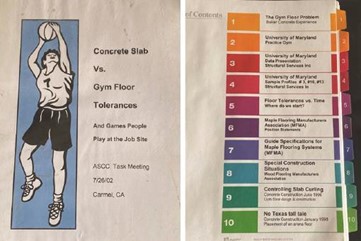Bruce Suprenant, Technical Director, The Voice Newsletter February 2020
Gym floors in schools—the battle between the concrete contractor and gym floor installers was the beginning of the ASCC Position Statements. Concrete contractors were meeting the F-numbers stated in the project specifications but the gym floor installers were not happy with the concrete surface. They did not like the F-number system and wanted an 1/8 in. in 10 ft. radius, measured when they arrived on site. They said that according to the Maple Flooring Manufacturers Association (MFMA), F-numbers didn’t apply to them. Concrete contractors said—say what? Maple who?
This battle took place in the late 1990’s and early 2000’s. I was at Baker Concrete at the time and we had been battling gym floor installers over projects across the US. At the time, Baker was constructing a new gym for the University of Maryland. They had won the NCAA basketball championship in 2002. At that time, concrete contractors could not convince others that F-numbers changed with time, and that the gym floor installer would not see the F-numbers the concrete contractor provided.
Part of the issue was the Commentary of ACI 117-90 “Standard Specifications for Tolerances for Concrete Construction and Materials.” It stated, “Since neither deflection nor curling will significantly change a floor’s FF value, there is no time limit on the measurement of this characteristic.” Baker hired Structural Services to measure the F-numbers, first in November 2001 within 72 hours after concrete placement, and second, in May 2002, five months later, when the gym floor installer arrived on site.
The results were as to be expected; the F-numbers changed with time. This information, along with other data, was presented in “The Concrete Floor Tolerance/Floor Covering Conundrum”, ACI Concrete International, July 2003. As a result of this information, the statement in ACI 117 about F-numbers not changing with time was removed in 2006.
During this time, The Aberdeen Group was hosting the CEO Forum. Ward was at ACI; part of his job was editor of Concrete International. I had worked for a number of years at The Aberdeen Group and was responsible for the Forum. At the July 2002 CEO Forum in Carmel, CA, Ward and I both attended, and I put together the notebook shown below for a meeting. That included a 30-minute presentation on the gym floor battle and the MFMA Position Statements. It stated: “The MFMA does not acknowledge the use of F-numbers to measure levelness/flatness tolerance in gymnasium slab applications”. The buzz at the CEO Forum was if the MFMA could tell the concrete contractor to pound salt with the F-numbers, concrete contractors could develop position statements to tell others to pound salt. Thus, the idea for ASCC position statements was born.
The effort to pledge fund this adventure was immediate and passionate. Tommy Ruttura, Ruttura & Sons, and Rocky Geans, L.L. Geans Construction, were outspoken supporters. Five months after the Forum, in January 2003, ACI published Position Statement #1 “Hard Trowel Finish on Air-entrained Concrete”. That started a string of 25 ASCC Position Statements, all published by ACI, ending in February 2005. ACI started to publish them again in October 2009. ACI Concrete International has continued to publish these with ASCC PS #44 published in June 2019. We anticipate ASCC PS #45 on water-cement ratio to be published this year. In addition, the Concrete Polishing Council (CPC) has published five position statements in ACI Concrete International including #5 in March 2020.
Quite an accomplishment from the beginning in 2002 to having 50 ASCC Position Statements. And still counting………
